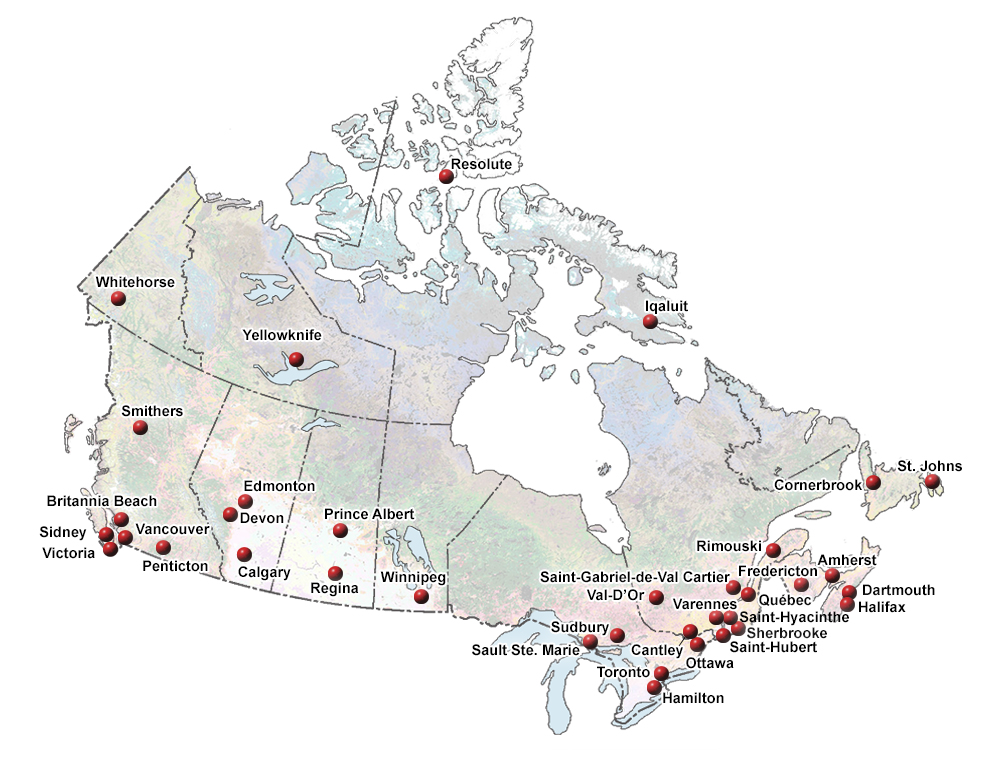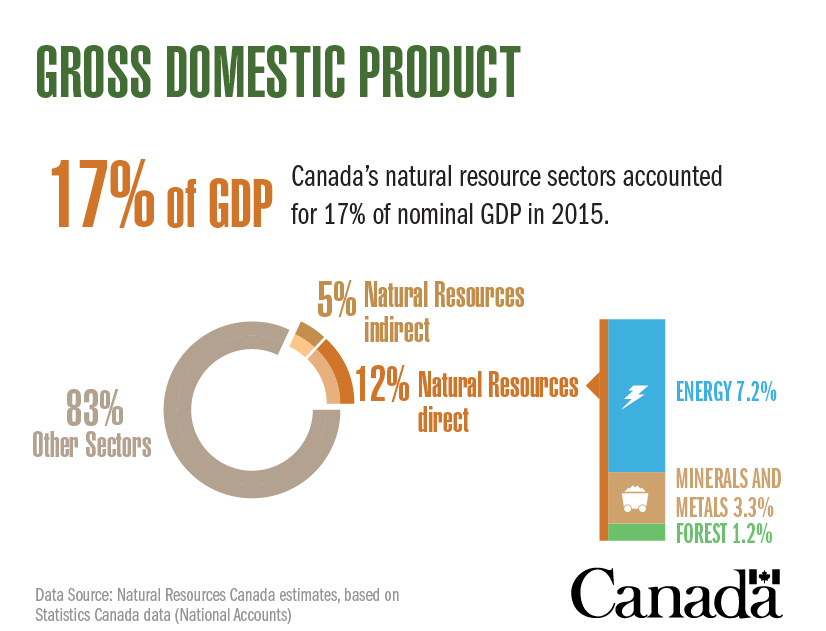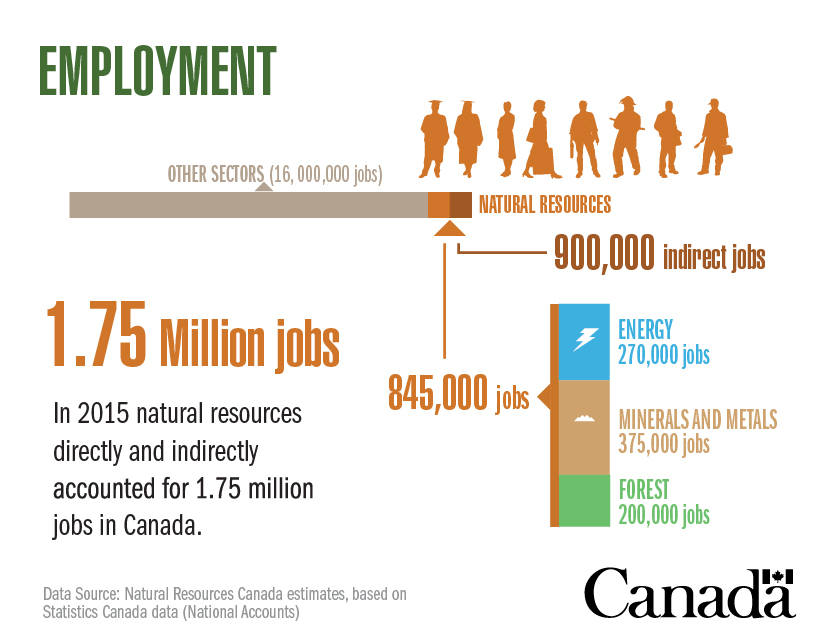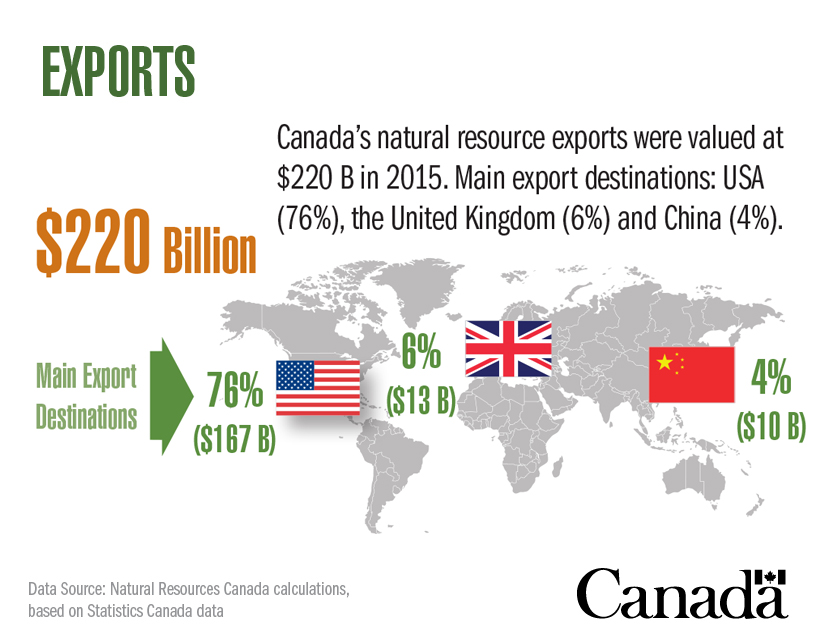Section I: Organizational Overview
Organizational Profile
Appropriate Minister: The Honourable James Gordon Carr, P.C., M.P.
Institutional Head: Christyne Tremblay
Ministerial Portfolio:
- Atomic Energy of Canada Limited i (AECL);
- National Energy Board ii (NEB);
- Canadian Nuclear Safety Commission iii (CNSC);
- Canada-Newfoundland and Labrador Offshore Petroleum Board iv (CNLOPB);
- Canada-Nova Scotia Offshore Petroleum Board v (CNSOPB);
- Northern Pipeline Agency vi (NPA);
- Sustainable Development Technology Canada vii (SDTC) Footnote 1; and
- Energy Supplies Allocation Board (ESAB) (inactive).
Year of Incorporation / Commencement: 1994
Main legislative authorities:
- Department of Natural Resources Act, viii S.C. 1994, c. 41
- Forestry Act, ix R.S.C., 1985, c. F-30
- Resources and Technical Surveys Act, x R.S.C., 1985, c. R-7
- Energy Efficiency Act, xi S.C. 1992, c. 36
Organizational Context
Raison d’être
The vision of NRCan is to improve the quality of life of Canadians by creating a sustainable resource advantage – now and for the future. It seeks to achieve this vision by working to improve the competitiveness of the natural resource sectors and to grow their contribution to Canada’s economy. NRCan supports the responsible development of Canada’s resources in a manner that advances the country’s global standing as a leader on the environment, and uses its knowledge and expertise of Canada’s landmass to support the safety and security of citizens.
Responsibilities

Text version
Map of Canada
Map locating NRCan offices and laboratories in Canada.
The Minister of Natural Resources has responsibilities in relation to more than 30 acts of Parliament. The Minister’s core powers, duties and functions are set forth in the Department of Natural Resources Act, the Resources and Technical Surveys Act, the Forestry Act and the Energy Efficiency Act. The Department also works in areas of shared responsibilities with provinces, which include the environment, public safety, economic development, science and technology, and consultations with Indigenous Peoples. To fulfil its responsibilities, the Department relies on a number of instruments (e.g., policy, regulation, statutory transfers, grants and contributions) and key activities (e.g., science and technology, partnerships and communications).
NRCan has offices and laboratories across the country. About one third of its employees are located in the National Capital Region, with the remainder distributed from Atlantic Canada, through Quebec and Ontario, to the Western and Pacific Regions and Northern Canada.
Strategic Outcomes and Program Alignment Architecture
- SO 1: Canada’s Natural Resource Sectors are Globally Competitive
- Program 1.1: Market Access and Diversification
- Sub-Program 1.1.1: Mineral and Metal Markets Access and Development
- Sub-Program 1.1.2: Forest Products Market Access and Development
- Sub-Program 1.1.3: Energy Market Regulation and Information
- Program 1.2: Innovation for New Products and Processes
- Sub-Program 1.2.1: Mining Innovation
- Sub-Program 1.2.2: Forest Sector Innovation
- Sub-Program 1.2.3: Geospatial Innovation
- Program 1.3: Investment in Natural Resource Sectors
- Sub-Program 1.3.1: Mineral Investment
- Sub-Program 1.3.2: Targeted Geoscience Initiative (TGI)
- Sub-Program 1.3.3: Geo-mapping for Energy and Minerals
- Sub-Program 1.3.4: New Energy Supply
- Sub-Program 1.3.5: Major Projects Management Office Initiative
- Program 1.4: Statutory Programs – Atlantic Offshore
- Program 1.1: Market Access and Diversification
- SO 2: Natural Resource Sectors and Consumers are Environmentally Responsible
- Program 2.1: Energy-Efficient Practices and Lower-Carbon Energy Sources
- Sub-Program 2.1.1: Renewable Energy Deployment
- Sub-Program 2.1.2: Support for Clean Energy Decision-Making
- Sub-Program 2.1.3: Alternative Transportation Fuels
- Sub-Program 2.1.4: Energy Efficiency
- Program 2.2: Technology Innovation
- Sub-Program 2.2.1: Materials for Energy
- Sub-Program 2.2.2: Green Mining
- Sub-Program 2.2.3: Clean Energy Science and Technology
- Program 2.3: Responsible Natural Resource Management
- Sub-Program 2.3.1: Forest Ecosystem Science and Application
- Sub-Program 2.3.2: Groundwater Geoscience
- Sub-Program 2.3.3: Environmental Studies and Assessments
- Sub-Program 2.3.4: Radioactive Waste Management
- Sub-Program 2.3.5: Earth Observations for Responsible Resource Development
- Program 2.1: Energy-Efficient Practices and Lower-Carbon Energy Sources
- SO 3: Canadians have Information to Manage their Lands and Natural Resources, and are Protected from Related Risks
- Program 3.1: Protection for Canadians and Natural Resources
- Sub-Program 3.1.1: Explosives Safety and Security
- Sub-Program 3.1.2: Materials and Certification for Safety and Security
- Sub-Program 3.1.3: Forest Disturbances Science and Application
- Sub-Program 3.1.4: Climate Change Adaptation
- Sub-Program 3.1.5: Geohazards and Public Safety
- Program 3.2: Landmass Information
- Sub-Program 3.2.1: Essential Geographic Information
- Sub-Program 3.2.2: Canada’s Legal Boundaries
- Sub-Program 3.2.3: Polar Continental Shelf Logistics Support
- Sub-Program 3.2.4: United Nations Convention on the Law of the Sea
- Program 4.1: Internal Services
- Program 3.1: Protection for Canadians and Natural Resources
Operating Environment and Risk Analysis
Canada is a nation rich in natural resources. Its energy, minerals and metals and forest resources bring large economic benefits, accounting for about 17 percent of Canada’s nominal gross domestic product (GDP), 1.75 million jobs and approximately half of Canada’s merchandise exports ($220 billion in 2015).

Text version
Gross Domestic Product
Infographic showing that Canada’s natural resource sectors accounted for 17% of nominal GDP in 2015.

Text version
Employment
Infographic showing that natural resources directly and indirectly accounted for 1.75 million jobs in Canada in 2015.

Text version
Exports
Infographic showing that Canada’s natural resource exports were valued at $220 B in 2015.
Natural resources are also critical determinants of Canada’s environmental performance. Their development and use accounts for the vast majority of our greenhouse gas (GHG) emissions and affect air, water and soil quality, public health and safety, and biodiversity and conservation.
Natural resources are thus at the nexus of Canada’s economic and environmental agendas. Our collective challenge, which is also our key opportunity, is to set and implement a plan ensuring the growth of the resource sectors, while protecting the environment.
The Paris Agreement, which aims to limit the global average temperature rise to well below 2 degrees Celsius, includes clear targets and timelines. For Canada, it means reducing GHG emissions by 30 percent from the 2005 level by 2030.
In 2014, Canada's total GHG emissions were 732 megatonnes (Mt) of carbon dioxide equivalent (CO2 eq), or 20 percent (120 Mt CO2 eq) above the 1990 emissions of 613 Mt CO2 eq. Footnote xii Reaching the 2030 target will be challenging; success will require a concerted effort from all Canadians.
Another key challenge is effective stakeholder engagement – from other federal departments to provincial and territorial governments and Indigenous communities, from natural resource industries to consumers and academia. Evolving jurisprudence on consultations with Indigenous communities has also called into question what constituted meaningful consultations, a key decision-making component on projects impacting traditional lands.
Natural resource industry revenues have also been affected by lower commodity prices. Crude oil and liquefied natural gas prices have fallen by over 60 percent since June 2014; similarly, mineral and metal prices have been on a downward trend since 2011 and hit significant lows in 2015-16. Market access, investment climate, wildfires, hazards and emergency management remain ever-present risks requiring NRCan’s continued attention.
Working together and implementing a sound plan will set the foundation for providing Canada with a competitive advantage, improving public confidence in the regulatory system and will help to set the global standard for environmental excellence.
The key strategies deployed by the Department to manage these risks are outlined below.
Key Risks
|
Risk |
Risk Response Strategy |
Link to the Organization’s Programs |
|---|---|---|
|
Climate Change |
||
|
If Canada’s actions to meet international climate change commitments are insufficient and if Canada fails to keep pace in adapting to climate change, then the competitiveness of Canada’s natural resource sectors could be threatened. |
In 2015-16, NRCan’s risk response included:
Budget 2016 also provided funding for electric transportation infrastructure and demonstrations of clean technologies while earmarking over $1 billion for the development of a clean technology strategy including for natural resource sectors. |
Canada’s Natural Resource Sectors are Globally Competitive |
|
Market Access and Investment Climate |
||
|
If Canada fails to respond to changing market dynamics such as shifting energy demand to new markets and declining demand from the U.S. or fails to maintain an appropriate investment climate, then energy resource sectors may lose opportunities. |
In 2015-16, NRCan’s risk response included:
Funding was announced in Budget 2016 to:
Budget 2016 also earmarked over $1 billion over four years, starting in 2017-18 to support clean technology including in the natural resource sector. |
Canada’s Natural Resource Sectors are Globally Competitive |
|
Hazards and Emergency Management |
||
|
If Canada does not have sufficient safeguards in the event of a natural or human-driven incident, then it may negatively impact Canadians, the security of Canada’s natural resource infrastructure and Canada’s overall economy. |
In 2015-16, NRCan’s risk response included:
|
Canadians have Information to Manage their Lands and Natural Resources, and are Protected from Related Risks |
Organizational Priorities
While NRCan’s core mandate remains anchored in its enabling legislation (see Organizational Context), the Department’s priorities shift from year to year in response to the global and domestic context (see Operating Environment and Risk Analysis).
In November 2015, the Prime Minister asked Minister Carr through his mandate letter, to:
- Work collaboratively with provinces and territories to advance the Canadian Energy Strategy;
- Work with the Minister of Innovation, Science and Economic Development and other responsible ministers to develop a Clean Technology Strategy for Canada to encourage investment in clean energy technologies in the natural resource sector;
- Support the Minister of Environment and Climate Change in reviewing Canada’s environmental assessment process, including developing interim measures to guide decision-making on major natural resources projects while the review is under way;
- Develop a path forward to modernize the NEB; and
- Develop an ambitious North American clean energy and environment agreement.
NRCan is collaborating and engaging with provinces, territories and Indigenous peoples to design and put in place the right policies and programs, informed by science, to deliver on these mandate letter commitments and on the department’s broader legislative mandate.
In 2015-16, NRCan put in place its plans and made some significant early steps towards meeting these commitments.
Canadian Energy Strategy
Priority Type Footnote 2
New
Key Supporting Initiatives
|
Planned Initiatives |
Link to the Organization’s Programs |
|
NRCan will work with the provinces and territories on the Canadian Energy Strategy, to support the transition towards a lower carbon future and to ensure Canada is positioned as a global leader in the sustainable development and use of the full range of its energy assets. |
1.1
|
|
Progress Toward the Priority |
|
|
The Government of Canada has made a commitment to work with the provinces and territories to advance joint actions to support Canada's transition towards a lower carbon future. In March 2016, First Ministers tasked federal, provincial and territorial Energy Ministers to collaborate on specific actions undertaken through the Canadian Energy Strategy – energy efficiency, clean energy technology and innovation, and delivering energy to people – and to report back on progress in fall 2016. NRCan has also worked with provinces and territories to develop technical reports, including on areas such as Adaptation, the Built Environment, Electricity Generation and Transmission, and Agriculture and Forestry, which will support key objectives of both the Canadian Energy Strategy and the Pan-Canadian Framework on Clean Growth and Climate Change. |
|
Investments in Clean Technology
Priority TypeFootnote 3
New
Key Supporting Initiatives
|
Planned Initiatives |
Link to the Organization’s Programs |
|
NRCan, in collaboration with partners, will develop a strategy for investing in clean technology across Canada. This will include engaging nationally to develop measures to support clean technology producers and clean technology development and use in the natural resource sectors. It will also include implementing Mission Innovation commitments, a new global initiative aimed at accelerating clean energy technology innovation over the next five years to address climate change, provide affordable and reliable clean energy, and promote economic growth. |
1.1 1.2 2.2 |
|
Progress Toward the Priority |
|
|
In November 2015, Prime Minister Trudeau announced Canada’s participation in Mission Innovation, a global initiative of 20 countries and the EU, working together to accelerate clean energy innovation. Canada agreed to double federal investments in clean technology innovation over five years, promote greater private sector investment in early stage clean technology development in Canada and increase collaborative efforts with key domestic and international partners. NRCan, in collaboration with ISED, Agriculture and Agri-Food Canada (AAFC) and the Department of Fisheries and Oceans (DFO), is developing a whole-of-government strategy to advance clean technology, including in the natural resource sectors. This strategy is being informed by comprehensive engagement including ten ministerial roundtables and outreach to more than 300 stakeholders since late 2015. It will identify priorities for the Budget 2016 commitment to invest over $1 billion over 4 years in clean technology, including in the natural resource sectors, as well as maximize the range of federal clean technology policy and program instruments. Budget 2016 announced funding for programs to improve energy efficiency and to reduce the environmental impacts of energy production and use while increasing productivity and competitiveness. NRCan led the design on these programs including new energy research, development and demonstration (RD&D) programming for the deployment of electric vehicle infrastructure, clean energy technology, cleaner oil and gas technologies, and improved data on the clean technology sector. |
|
Interim Measures in Support of the Environmental Assessment Process Review
Priority TypeFootnote 4
New
Key Supporting Initiatives
|
Planned Initiatives |
Link to the Organization’s Programs |
|
Under the leadership of ECCC, NRCan is working with federal partners to review and restore confidence in Canada’s environmental assessment processes by ensuring that views from the public being sought and considered, and that decisions are based on science, traditional knowledge of Indigenous peoples and other relevant evidence. |
1.1 1.3 2.2 |
|
Progress Toward the Priority |
|
|
In January 2016, NRCan, together with ECCC, developed an Interim Strategy comprised of five principles to guide federal decision-making on major natural resource projects while the Government undertakes a review of the federal environmental assessment process. For two significant projects under NEB review, the Trans Mountain Expansion Project and the Energy East Pipeline, interim measures were implemented to ensure consistency with the five principles including:
The principles and specific measures for pipeline reviews (e.g., time limit extensions that create space for deeper consultations with Indigenous peoples), are key first steps in delivering the Government’s commitment to review and restore public confidence in the federal environmental assessment processes. NRCan established a governance structure to coordinate mandated reviews related to environmental assessments between the Canadian Environmental Assessment Agency (CEAA), Fisheries and Oceans Canada (DFO), and Transport Canada (TC). NRCan also contributed advice to ECCC on the application of GHG emissions targets to non-energy projects, such as mining. |
|
Modernization of the National Energy Board
Priority TypeFootnote 5
New
Key Supporting Initiatives
|
Planned Initiatives |
Link to the Organization’s Program |
|
|
NRCan will take steps to modernize the NEB, to ensure that its composition reflects regional views and that it has sufficient expertise in fields such as environmental science, community development, and Indigenous traditional knowledge. |
1.1 |
|
|
Progress Toward the Priority |
||
|
NRCan is leading a review of the NEB’s structure, role and mandate, to position the NEB as a modern, efficient, and effective energy regulator. To commence the review, in 2015-16 NRCan:
|
||
North American Energy Collaboration
Priority TypeFootnote 6
New
Key Supporting Initiatives
|
Planned Initiatives |
Link to the Organization’s Program |
|
NRCan will work in partnership with the U.S. and Mexico with the objective of strengthening and advancing continental clean energy cooperation in support of an ambitious North American clean energy and environment agreement. |
1.1 |
|
Progress Toward the Priority |
|
|
In February 2016, Minister Carr and his counterparts from Mexico and the U.S. met in Winnipeg, Manitoba, for the North American Energy Ministers Meeting. The energy leaders signed a MOU on Climate Change and Energy Collaboration, which expanded and deepened the energy relationship between the three countries. Under the MOU, 18 projects are at various stages of implementation across the four broad themes of energy data, clean energy, infrastructure and Mission Innovation. Examples of projects include:
The MOU has increased collaboration and information-sharing on key areas such as low-carbon electricity, clean technologies, energy efficiency, carbon capture and storage, climate change adaptation, and reducing emissions from the oil and gas sector (including methane). Trilateral cooperation has contributed directly to the successful statement announced by Leaders’ on continental clean energy and environmental collaboration in June 2016. Results from early collaboration are now being analyzed to determine next steps to continue to advance North American Energy Cooperation. |
|
Page details
- Date modified: